Menus
- First test ride with the retro bike
- Get in the saddle and go
- Bowing to the classic models
- Strength in the first half of the speed
- Rich sound despite Euro 4
- Space for longer drivers too
- Purchase price of 12,500 euros
- Inspiration kits for the Triumph Bonneville Bobber
- Old school bobber
- Quarter Mile Bobber
- Technical data Triumph Bonneville Bobber

triumph
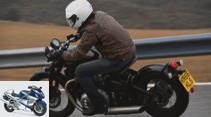

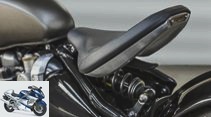
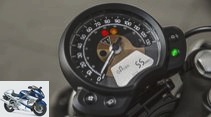
16 photos
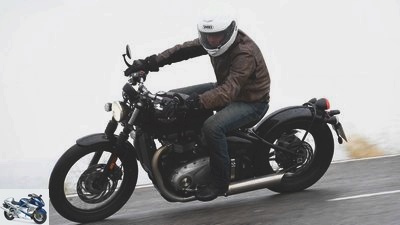
triumph
1/16
The first test drive with the new Triumph Bonneville Bobber.
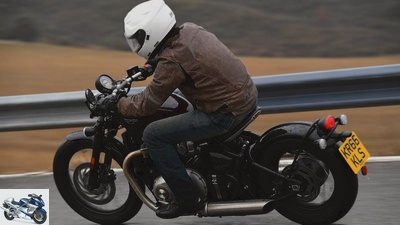
triumph
2/16
Unfortunately, the weather didn’t play along on the day of the test, so the new Bobber had to prove its qualities on wet roads.
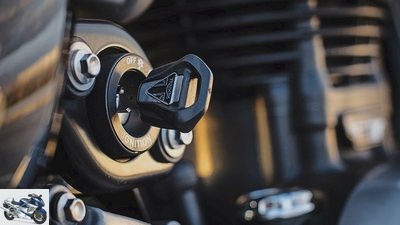
triumph
3/16
For a tidy cockpit: Stylish ignition lock on the frame triangle.
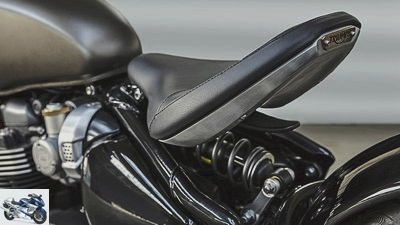
triumph
4/16
The bench plate made of brushed aluminum is an eye-catcher with the screwed-on emblem.
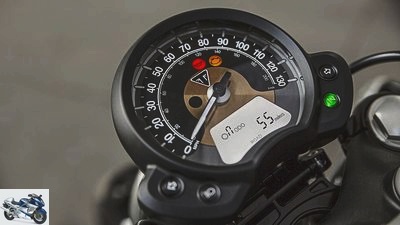
triumph
5/16
Speedometer adjustable in inclination, speed can be displayed in the LCD field.
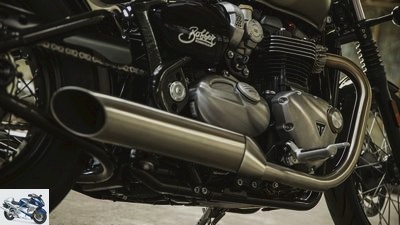
triumph
6/16
Triumph Bonneville Bobber.

triumph
7/16
… If you put 300 euros on the black bobber, you will receive a chic two-tone paint finish in green and silver.
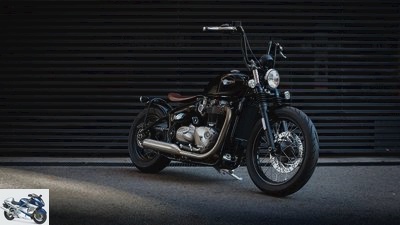
triumph
8/16
The bobber is not independent enough for you? Triumph offers a wide range of accessories for this case. And two conversion kits. Old school bobber …
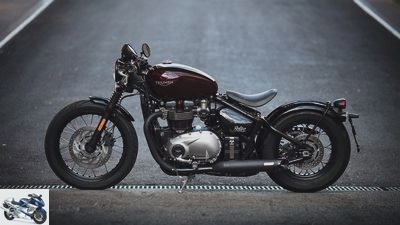
triumph
9/16
… and Quarter Mile Bobber.

triumph
10/16
Triumph Bonneville Bobber.
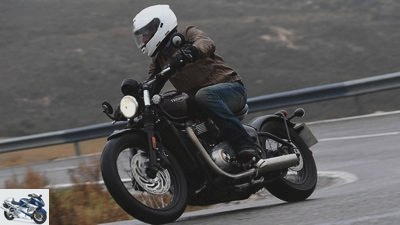
triumph
11/16
Triumph Bonneville Bobber.
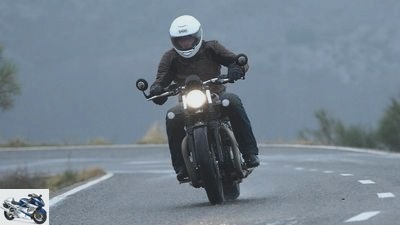
triumph
12/16
Triumph Bonneville Bobber.
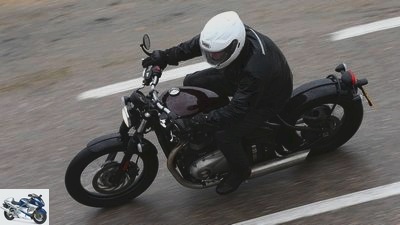
triumph
13/16
Triumph Bonneville Bobber.
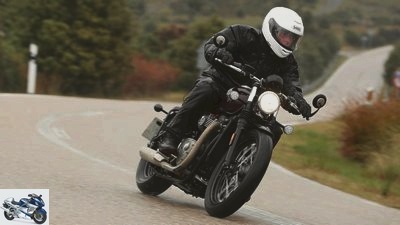
triumph
14/16
Triumph Bonneville Bobber.
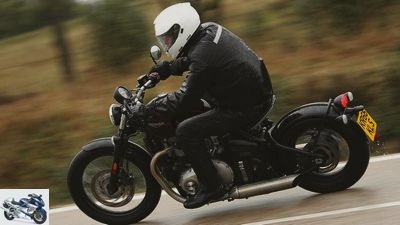
triumph
15/16
Triumph Bonneville Bobber.
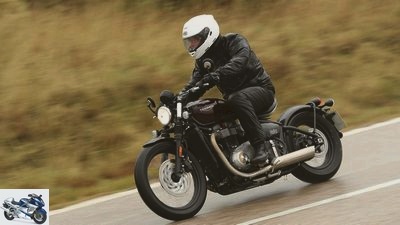
triumph
16/16
Triumph Bonneville Bobber.
Triumph Bonneville Bobber in the driving report
First test ride with the retro bike
With the Triumph Bonneville Bobber, Triumph seems to have hit the mark. Never before have there been so many pre-orders for a new model. For soloists who don’t feel like going to the customizer, it offers pure retro charm off the rack, plenty of torque and – if that’s not enough – two design packages and a wide range of accessories to refine.
When it comes to building motorcycles that come across as super-classic, but are completely up-to-date in terms of driving dynamics, Triumph is currently not ahead of anyone. With the youngest member of the Bonneville family, they outdid themselves at Hinckley. Whereby the “youngest member” in view of the flawless 40s styling the Triumph B.onneville Bobber somehow doesn’t really fit. She seems to have traveled back in time. Narrow 19-inch front wheel, thick 16-inch rear wheel, plus the chassis, which, thanks to the cleverly hidden shock absorber, has the best rigid frame look. Not only the beautiful speedometer is adjustable in inclination. The saddle, which imitates a spring saddle with its brushed aluminum base plate, can be moved horizontally by 30 millimeters.
Buy complete article

Triumph Bonneville Bobber in the driving report
First test ride with the retro bike
Reduced to the essentials
Another highlight only becomes apparent at second glance: The Triumph Bonneville Bobber looks unbelievably tidy and reduced to the essentials. No cables, lines or plugs disturb the picture. You look in vain for the ABS control unit. And the expansion tank or the rear brake fluid tank are hidden behind an aluminum cover between the swing arm bearing and the engine. Only then does the illusion of an oldie work. In order to make this as perfect as possible, the British have left out no detail. From the metal strap around the battery box to the rear wheel hub in the shape of a drum brake to the round instrument, everything looks like from a bygone, glamorous era. The Bobber cannot do without electronics either, but with ABS, two motor mappings and a traction control that can be switched off, it is limited to the bare minimum.
Get in the saddle and go
A new exhaust with short, angled mufflers, a two-part airbox and an adapted mapping – that’s how they strengthened the mid-rev range in Hinckley for the twin. The result: Its 106 Nm should be available at 4,000 rpm. If those aren’t good prospects for relaxed gliding. Unfortunately, the views outside of our hotel are not quite as exciting. At eight degrees, one or two dozen Triumph Bonneville Bobbers are neatly lined up in the continuous rain for a tour into the hinterland of Madrid. Which is why our colleagues from the Spanish sister magazine Motociclismo also contribute the photos to this story. Gracias Colegas. But whatever. Get in the saddle and go.
Bowing to the classic models
The starting procedure begins with a kind of bow, because the ignition lock is attached underneath the right thigh in proper style. Also a bow to the classic models. Then pressure on the starter, and the twin babbles excited and surprisingly full-bodied out of the brushed mufflers. The seating position is typical of a roadster, with notches at the front and flat handlebars. And with the saddle in the foremost position, that works well, at least for smaller riders. The further we feel our way into the hinterland, the more hope for dry roads dwindles. Petrus has obviously had a bad day. Thanks to the Avon Cobra rubbers in 100 / 90-19 and 150/80 R 16 specially developed for the Triumph Bonneville Bobber, which offer really good wet grip, the ride does not degenerate into an egg dance. So you can swing briskly over the wet, winding streets. And the optional heated grips also keep your fingers warm.
Strength in the first half of the speed
The revised twin has exactly the right characteristics for a bobber. Its strength lies in the first half of the speed. There it does not apply its pressure like a raid, but as a broad torque plateau on which you can relax and surf out of the corners. Its comfort zone extends up to just over 4,500 rpm. Of course it can also be twirled up to the limiter at 7,000 rpm, but it does so without any particular passion and with increasing vibrations. He prefers to tense his muscles at the exit of the bend in the lower rev range, toil confidently through the rev range and push the Triumph Bonneville Bobber forward with a full punch.
Rich sound despite Euro 4
The Triumph Bonneville Bobber doesn’t greedily rush from one corner to the next. Requires a little pressure on the handlebars and then, typical for 19-inchers, steers in more prudently than sharply. Sailing from bend to bend in finely curved arcs is her thing, not hectic corner robbery. After all, according to Triumph, 228 kilos of dry weight want to be moved. Once in an inclined position, it pulls its course cleanly. The newly tuned telescopic fork works inconspicuously in the best sense of the word, the rather softly tuned shock absorber neatly filters out small bumps and long waves. Short, hard edges and transverse joints are discreetly passed on to the driver. Despite the deflection, it has to be modest like the fork with just under 90 millimeters of travel.
What is really in the chassis of the Triumph Bonneville Bobber has to be shown only in a test on dry roads. In contrast, the front single-disc brake looks rather pale. Dull in response, at least when it is wet, it demands a good grip. But a set of sharper brake pads should help. But because the Avon tires, as I said, are a benchmark in the wet and allow a rather brisk line, the High Torque Twin is now getting more and more spurs. He appreciates that with wonderfully robust, never intrusive, loud roadster tubes. Who says that Euro 4 cannot produce a great soundscape?
Space for longer drivers too
During a short refueling stop, just under 5.7 liters gurgled into the 9.1 liter tank of the Triumph Bonneville Bobber after 120 kilometers. Which corresponds to a consumption of 4.7 liters. Moved a little more cautiously, the consumption can certainly be pushed a good deal towards the 4.1 liters proclaimed by Triumph. Which means that stages of almost 200 kilometers are also feasible. Quickly unpack the wrench, fix the saddle 30 mm backwards and thus 10 mm lower. This means that even longer drivers have enough space. However, this position is not more comfortable for the buttocks.
Purchase price of 12,500 euros
Nevertheless, the signs should point to success for the Triumph Bonneville Bobber built in Thailand. Not only because of the 16,000 maintenance intervals. With a purchase price of 12,500 euros, this ingenious mixture of optics, sound and refinement options, many a bargain stocking could get on the collar. Triumph has two inspiration kits ready. The “Old School Bobber” kit with Ape Hanger, Vance & Hines exhausts and matching accessories as well as the “Quarter Mile Bobber” kit with stub handlebars, matt black Vance & Hines bags and corresponding attachments. The final prices have not yet been determined, but should be around 1,800 euros. And if that’s not individual enough, you can put together your very own bobber from over 150 accessories.
Inspiration kits for the Triumph Bonneville Bobber
The bobber is not independent enough for you? In this case, Triumph offers a wide range of accessories. And two conversion kits. That’s an announcement: Triumph offers over 150 different accessories for refining and customizing the bobber. The two conversion kits that trim the Triumph Bonneville Bobber in completely different directions should be of particular interest. The “old school” kit with ape hanger handlebars brings the bobbers very close to their models from the forties. The “Quarter Mile” kit pushes them hard in the direction of drag racers. The prices for the kits have not yet been finalized, but are expected to be around 1,500 to 1,600 pounds, which is roughly 1,800 euros.
Old school bobber
triumph
Old school bobber.
- Chrome-plated ape hanger kit
- Line kit for the higher handlebar
- Vance & Hines exhausts, brushed with rotating end caps
- short front mudguard, painted
- Brown leather saddle
- Grips brown
- black luggage bag for mounting on the swing arm
- CNC-milled lamp ring
- Brushed, ribbed cover for alternator, clutch and throttle valve sensor
- Oil cap
Quarter Mile Bobber
triumph
Quarter Mile Bobber.
- Handlebar stub kit
- Manifold black
- Vance & Hines exhausts, black / brushed, with rotatable end caps
- short front mudguard, painted
- Black leather saddle
- Black grip rubbers
- Ribbed cover for throttle valves, black
- CNC-milled lamp ring black
- Brushed, ribbed cover for alternator and clutch black
- Oil cap
Technical data Triumph Bonneville Bobber
Triumph Bonneville Bobber
engine
Water-cooled two-cylinder four-stroke in-line engine, two balance shafts, an overhead, chain-driven camshaft, four valves per cylinder, fork rocker arms, wet sump lubrication, injection, 2 x Ø 44 mm, regulated catalytic converter, 540 W alternator, 12 V / 10 Ah battery, mechanically operated multiple discs -Oil bath clutch (anti-hopping), six-speed gearbox, chain, secondary gear ratio 2.176.
| Bore x stroke | 97.6 x 80.0 mm |
| Displacement | 1,197 cc |
| Compression ratio | 10.0: 1 |
| rated capacity | 57.0 kW (77 hp) at 6,100 rpm |
| Max. Torque | 106 Nm at 4,000 rpm |
landing gear
Double loop frame made of steel, telescopic fork, Ø 41 mm, two-arm swing arm made of steel, central spring strut with lever system, adjustable spring base, front disc brake, Ø 310 mm, double-piston floating caliper, rear disc brake, Ø 255 mm, double-piston floating caliper, traction control, ABS.
| Spoked wheels with aluminum rims | 2.50 x 19; 3.50 x 16 |
| tires | 100 / 90-19; 150/80 R 16 |
Dimensions + weights
Wheelbase 1510 mm, steering head angle 64.2 degrees, caster 88 mm, spring travel front / rear 90/90 mm, seat height 690 mm, dry weight 228 kg, permissible total weight 453 kg, tank capacity 9.1 liters.
| guarantee | two years |
| Colours | Black, gray, red, green / silver |
| price | from 12,500 euros |
| Additional costs | 450 euros |
Related articles
-
Family comparison Triumph Bonneville T120 Black, Bobber Black, Speedmaster (2018)
Jacek Bilski 19th photos Jacek Bilski 1/19 The Bonneville family competes for comparison. Jacek Bilski 2/19 Triumph Bonneville Bobber Black. Jacek Bilski…
-
Driving report Triumph Tiger Third force It’s great that we have alternatives: the completely new Triumph Tiger, another top-class travel enduro, slides…
-
Driving report: Triumph America-Speedmaster
archive Driving report: Triumph America / Speedmaster Chrome compact class – Triumph America / Speedmaster The America has been in the Triumph model…
-
Triumph Rocket III in the driving report: more and less
Triumph 9 pictures Triumph 1/9 Even more displacement and Newton meters, but at the same time the weight screwed down. Does not sound bad. Triumph 2/9 …
-
Triumph Street Twin in the driving report
Triumph 20 pictures Triumph 1/20 The scrambler conversion comes in a soft enduro look, but its chic exhaust is not approved. Triumph…
-
Triumph Bonneville Bobber Black in the driving report
Triumph Motorcycles 26th photos Triumph Motorcycles 1/26 Driving report Triumph Bonneville Bobber Black. Triumph Motorcycles 2/26 Driving report Triumph…
-
Driving report Triumph Tiger 800 XCx and XRx
triumph 31 photos triumph 1/31 triumph 2/31 triumph 3/31 triumph 4/31 triumph 5/31 triumph 6/31 triumph 7/31 triumph 8/31 triumph 9/31 triumph 10/31…
-
Driving report Triumph Thunderbird Sport
Driving report Triumph Thunderbird Sport A weird bird The Triumph Thunderbird as an athlete? Do a more powerful engine and firmer landing gear really…
-
Driving report Triumph Speed Triple R
triumph Driving report: Triumph Speed Triple R Triumph’s tightened naked bike The mother of all street fighters is not enough for you? Do you need it…
-
Triumph Scrambler conversions in the driving report
Henniges 27 pictures Henniges 1/27 … The steering stop is also larger. Henniges 2/27 Playful colorful details such as engine protection bars or footrests round …